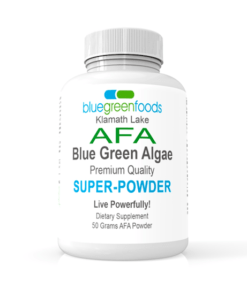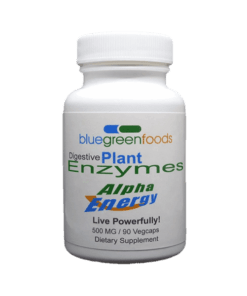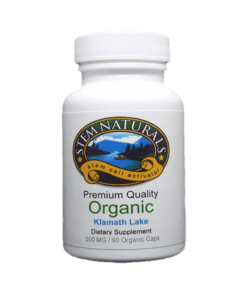-
×
 AFA 90cap 500mg | Klamath Lake Blue Green Algae 100% Organic
6 × $26.89
AFA 90cap 500mg | Klamath Lake Blue Green Algae 100% Organic
6 × $26.89 -
×
 AFA Crystals Bulk Powder - 5 lbs
6 × $400.00
AFA Crystals Bulk Powder - 5 lbs
6 × $400.00 -
×
 AFA Crystals Bulk Powder - 10lbs
6 × $620.00
AFA Crystals Bulk Powder - 10lbs
6 × $620.00 -
×
 Total Power
5 × $135.99
Total Power
5 × $135.99 -
×
 Power Duo is Stem Naturals and AFA Bluegreen Algae from Bluegreen Foods
6 × $69.95
Power Duo is Stem Naturals and AFA Bluegreen Algae from Bluegreen Foods
6 × $69.95 -
×
 Twin Pack 180 caps.
2 × $47.89
Twin Pack 180 caps.
2 × $47.89 -
×
 Alpha Energy Digestive Enzymes | Healthy Best Digestive Enzymes
1 × $32.99
Alpha Energy Digestive Enzymes | Healthy Best Digestive Enzymes
1 × $32.99 -
×
 AFA 90 500mg Bonus 6-Pack 540 Capsules | Blue Green Algae Nutrition Supplement
7 × $135.54
AFA 90 500mg Bonus 6-Pack 540 Capsules | Blue Green Algae Nutrition Supplement
7 × $135.54 -
×
 Power Trio
3 × $89.95
Power Trio
3 × $89.95 -
×
 Natural Stem Cell Supplement | Stem Cell Activator 90cap 500 MG
1 × $46.97
Natural Stem Cell Supplement | Stem Cell Activator 90cap 500 MG
1 × $46.97 -
×
 Mind Enhance | Best Brain Memory Supplement for Adults & Students
2 × $26.89
Mind Enhance | Best Brain Memory Supplement for Adults & Students
2 × $26.89 -
×
 AFA 90 500mg Bonus 6-Pack 540 Capsules | Blue Green Algae Nutrition Supplement Aphanizomenon flos-aquae
3 × $135.54
AFA 90 500mg Bonus 6-Pack 540 Capsules | Blue Green Algae Nutrition Supplement Aphanizomenon flos-aquae
3 × $135.54
Digestive Enzymes FAQs
WHAT ARE DIGESTIVE ENZYMES AND HOW DO THEY FUNCTION IN THE BODY?
Enzymes are essential substances found in the body that function as biological catalysts to help break down foods so that they can be properly absorbed and utilized. The primary digestive enzymes are known as proteases (break down proteins), amylases (break down carbohydrates and starches), and lipases (break down fats). The body naturally produces digestive enzymes however over time and with age enzyme insufficiency or decline in enzymes production can occur. Additionally raw foods are known to contain natural enzymes that break down the foods as they are released with chewing. Cooking of foods actively destroys the naturally occurring enzymes in food. This problem in conjunction with enzyme deficiencies seen in many children on the autism spectrum adversely affects digestion and gastrointestinal function.
WHAT AMOUNT OR DOSE OF THE ENZYME SHOULD BE TAKEN?
The dosing for enzymes is based on the amount of foods ingested and not directly on the size, weight or age of the individual. It is recognized that significant variations exist in the dosing of enzymes for children with autism spectrum disorders. The recommendation is to start with smaller amounts of enzymes and gradually increase while observing for changes in gastrointestinal function and behavior. This will require making adjustments to find the optimal dose that provides the most optimal response. With larger meals additional enzymes may be utilized and with small meals or snacks smaller doses may be sufficient to provide adequate digestion of these foods.
HOW DO THE PLANT ENYZMES FUNCTION?
Plant enzymes are effective in improving digestion in a full range of gastrointestinal conditions including problems with hypochlorhydria/low stomach acids, with enzyme deficiencies, etc. The plant-based enzymes have the ability to digest a broad spectrum of foods throughout the length of the digestive tract because they are active in a pH range of 2 through 12. They start their digestive activities in the stomach, which has a very acidic pH of around 2. These enzymes continue their activity in the small intestine, with a pH of 4-8, and finally in the colon/large intestine, which has an alkaline pH range of 10-12.
WHY ARE THE PLANT BASED ENZYMES AN EXCELLENT CHOICE FOR THE AUTISTIC INDIVIDUAL?
The plant-based enzymes possess a number of important qualities that make them ideal for use with autistic children who have gastrointestinal abnormalities. They offer the broadest and most complete spectrum of enzyme activity, including protease, amylase, lactase, maltase, lipase, invertase/sucrase, and cellulase enzymes. This provides the most comprehensive approach to optimal digestion and relieves the pancreas of some of its burden of having to produce large quantities of enzymes for the thorough digestion of foods. Most importantly, these plant-based enzymes have been successfully and safely used in children with autism spectrum disorders.
WHAT ARE DIGESTIVE ENZYMES AND HOW DO THEY FUNCTION IN THE BODY?
Enzymes are essential substances found in the body that function as biological catalysts to help break down foods so that they can be properly absorbed and utilized. The primary digestive enzymes are known as proteases (break down proteins), amylases (break down carbohydrates and starches), and lipases (break down fats). The body naturally produces digestive enzymes however over time and with age enzyme insufficiency or decline in enzymes production can occur. Additionally raw foods are known to contain natural enzymes that break down the foods as they are released with chewing. Cooking of foods actively destroys the naturally occurring enzymes in food. This problem in conjunction with enzyme deficiencies seen in many children on the autism spectrum adversely affects digestion and gastrointestinal function.
ARE OUR ENZYMES HIGH QUALITY?
All of our enzyme supplements are all manufactured according to the highest pharmaceutical and nutraceutical standards. All of these formulations have been tested and are certified to be gluten and casein free.
HOW SAFE ARE THE PLANT-BASED ENZYMES?
Each strain is extensively screened to determine if the organism is capable of producing toxins. Only those organisms that do not produce any toxins are selected and follow-up testing of these organisms is undertaken to verify this. Use of the non-toxigenic strains of Aspergillus niger and Aspergillus oryzae are utilized in all of our enzyme formulations. According to the experts these enzymes are purified compounds that do not initiate infections or colonization. No cases of Aspergillus infections have ever been documented in association with the consumption of purified fermented fungal enzymes.ee.
CAN YOUR ENZYME SUPPLEMENTS BE USED IN THOSE WHO ARE ALLERGIC/ SENSITIVE?
All of our enzyme formulations are designed to be free of milk, casein, wheat, gluten, gliadin, corn, rice bran, soy, egg, yeast, sugar, starch, MSG, stearates, palmitates, artificial sweeteners, colors, flavors, preservatives, salicylates, and other common allergens. These digestive enzyme formulations are designed for the sensitive individual who requires a hypoallergenic formulation free of potentially reactive ingredients. All formulations are made without the use of rice bran or beetroot fiber as base ingredients. Only plant cellulose is used for encapsulation and, when needed, the essential amino acid L-leucine is used in place of other more commonly used lubricants (magnesium stearate, stearic acid).
SUGGESTIONS FOR ENZYME USE
CAN THE ENZYMES BE USED IN COOKING OR MIXED IN HOT BEVERAGES?
Avoid mixing the enzymes with food or beverages that will be heated above 118-120°F, as the activity of the enzymes will be adversely affected. These high heat exposures, along with microwaving, canning and baking can denature/destroy the activity of the enzymes.
WHEN IS THE BEST TIME TO TAKE ENZYME SUPPLEMENTS:
It is generally recommended that enzyme supplements be taken at the beginning or early on in the meal to assure appropriate digestion. The capsules may be swallowed whole or opened and mixed with a small amount of food or beverage and taken prior to or at the beginning of the meal. Most food stays in the upper part of the stomach for an hour and half so if the enzymes are not taken before or at the beginning of the meal they can be supplemented after the meal is started.
HOW MANY TIMES A DAY IS IT SAFE TO USE THE DIGESTIVE ENZYMES?
Digestive enzymes can be used with every meal and snack if that is necessary. Because their function is to thoroughly digest foods they can be used with all food exposures. Generally however most individuals will use the enzymes with the primary meals (three times daily) or if a problem food is eaten between meals and there is a need to provide optimal digestion for that food exposure..
IF MY CHILD EATS A SNACK OF POPCORN OR CEREAL OR CHIPS,SHOULD THEY USE THE ENZYMES AT THAT TIME?
If you find that taking the enzymes at meals and with these snacks provides better response than just with meals, then you might consider using them with snack foods. Some of these carbohydrate containing foods/snacks will be more optimally digested with a small amount of enzymes. So you can experiment and make the best choice based on the response.
CAN THE CAPSULES BE OPENED AND MIXED WITH FOODS AND/OR BEVERAGES?
The optimal way to take digestive enzymes is to open the capsule and mix the powder in a small amount of a beverage or in a portion of food, which can be than followed by the meal or snack. The capsules may also be swallowed whole at the beginning of the meal and since the foods generally stay in the upper part of the stomach for 90 minutes this is a more than adequate amount of time for the capsules to dissolve and mix with the foods in the stomach.
CAN THE ENZYMES BE TAKEN ALONG WITH PROBIOTIC SUPPLEMENTS WITHOUT HURTING THESE FRIENDLY BACTERIA?
The digestive enzymes can be taken at the same meal as the probiotics without affecting the potency or integrity of these friendly bacteria. Concern has been expressed that the enzymes will degrade the attachment factors needed for the probiotics to adhere to the intestinal membrane. Documentation does not support this and in fact probiotics actually produce natural digestive enzymes (lactase, etc.) as part of their functioning. Utilizing enzymes and probiotics together will offer an excellent combination to enhance and maintain gastrointestinal well-being. Some families however have described positive response when taking the enzymes at the beginning of the meal and the probiotics near the end of the meal.
ARE THE ENZYMES ADVERSELY AFFECTED BY THE USE OF ANY OF PRESCRIPTION MEDICATIONS, TRANSFER FACTOR, OR OTHER NUTRITIONAL SUPPLEMENTS?
The enzymes specifically function in degrading foods only and they do not break apart other compounds. This means that the enzymes should not adversely affect the potency or integrity of the prescription medications. However if there is any question regarding timing of pharmaceuticals/specialty compounds, than follow your physicians recommendations. If you wait two hours following the meal this is generally considered a very appropriate and safe time to take the transfer factor or other substances that require optimal conditions for absorption and utilization.
HOW MUCH OF A DIGESTIVE ENZYME IS NEEDED WITH MEALS?
The dosing for digestive enzymes is very individual and the amounts needed to thoroughly digest the foods will depend on the types and amounts of foods in the diet. For example a snack of an apple would not require a protein-digesting enzyme whereas a meal of a hamburger with cheese on a bun would. The dosing is always individual and for some only 1 capsule will be adequate, yet if there are larger amounts of food exposures in the diet then 2 capsules or more may be needed.
IS THERE ANY CONDITIONS IN WHICH THE ENZYMES SHOULD NOT BE TAKEN?
Use of digestive enzymes should not be taken in the absence of normal gastric mucosa, such as is found in individuals who have a peptic or gastric ulcer. Consult with a physician for specific recommendations regarding use of enzymes if these conditions exist.
|
Information provided on this site is for educational purposes only and not intended as a substitute for professional medical advice. These statements have not been evaluated by the Food and Drug Administration and are not intended to diagnose, treat, cure or prevent disease. Consult with your physician or healthcare professional for diagnosis of medical problems or prescribed treatments.
|






